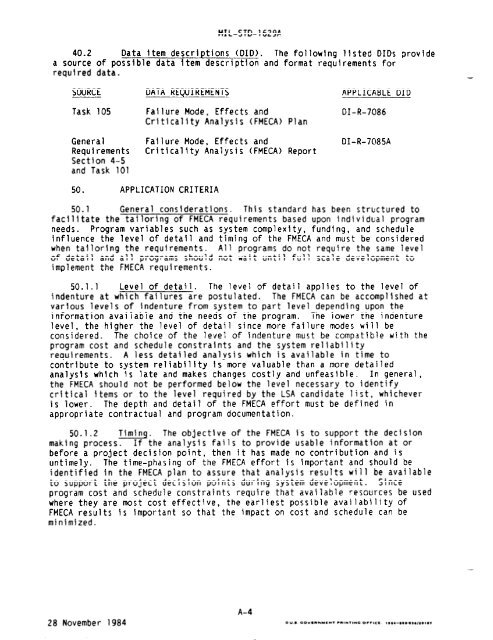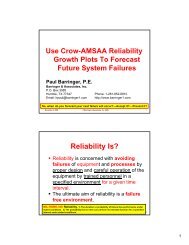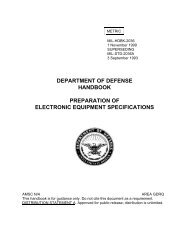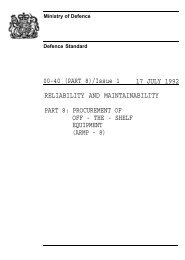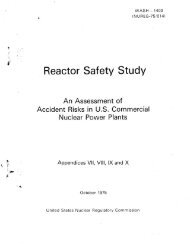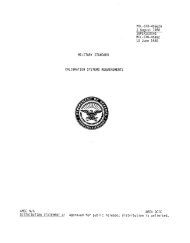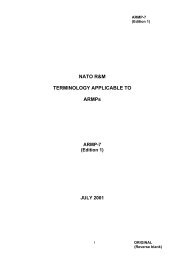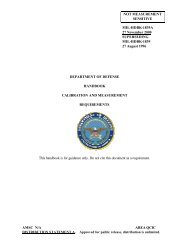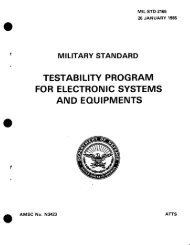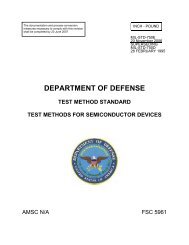MIL-STD-1629-RevA - Barringer and Associates, Inc.
MIL-STD-1629-RevA - Barringer and Associates, Inc.
MIL-STD-1629-RevA - Barringer and Associates, Inc.
You also want an ePaper? Increase the reach of your titles
YUMPU automatically turns print PDFs into web optimized ePapers that Google loves.
<strong>MIL</strong>-<strong>STD</strong>-<strong>1629</strong>A.40.2 Data ttem descriptions (DID). The following listed DIDs providea source of possible data Item description <strong>and</strong> format requirements forrequired data.SOURCE DATA REQUIREMENTS APPLICABLE DIDTask 105 Failure Mode, Effects <strong>and</strong> DI-R-7086Criticality Analysis (FMECA} PlanGeneral Failure Mode, Effects <strong>and</strong> DI-R-7085ARequirements Critlcallty Analysis (FMECA) ReportSection 4-5<strong>and</strong> Task 10150. APPLICATION CRITERIA50.1 General considerations. This st<strong>and</strong>ard has been structured tofacilitate the tailoring of FMECA requirements based upon individual programneeds. Program variables such as system complexity, funding, <strong>and</strong> scheduieinfluence the level of detail <strong>and</strong> timing of the FMECA <strong>and</strong> must be consideredwhen tailoring the requirements. All programs do not require the same levelof detail <strong>and</strong> all programs should not wait until full scale development toimplement the FMECA requirements.50.7.1 Level of detail. The level of detail applies to the level ofindenture at which failures are postulated. The FMECA can be accomplished atvarious levels of indenture from system to part level depending upon theinformation available <strong>and</strong> the needs of the program. The lower-the indenturelevel, the higher the level of detail since more failure modes will beconsidered. The choice of the level of indenture must be compatible with theprogram cost <strong>and</strong> schedule constraints <strong>and</strong> the system reliabilityrequirements. A less detailed analysis which is available in time tocontribute to system reliability is more valuable than a more detai?edanalysis which Is late <strong>and</strong> makei changes costly <strong>and</strong> unfeasible. In general,the FMECA should not be performed below the level necessary to identifycritical Items or to the level required by the LSA c<strong>and</strong>idate list, whicheveris lower. The depth <strong>and</strong> detail of the FMECA effort must be defined inappropriate contractual <strong>and</strong> program documentation.50.1.2 w- The objective of the FMECA is to support the declslonmaking process. If the analysis fails to provide usable information at orbefore a project decision point, then it has made no contribution <strong>and</strong> isuntimely. The time-phasing of the FMECA effort is important <strong>and</strong> should beidentified in the FMECA plan to assure that analysis results will be availableto support the project decision points during system development. Sinceprogram cost <strong>and</strong> schedule constraints require that available resources be usedwhere they are most cost effective, the earliest possible availability ofFMECA results is Important so that the impact on cost <strong>and</strong> schedule can beminimized.—28 November 1984*u.m. GovsnMMcwTPRINTIMG OF?ICC 1904-0ss+s0/10167A-4


